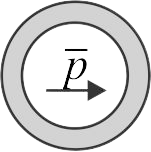358172
A short electric dipole of dipole moment \({\vec p}\) is placed at a distance \(r\) from the centre of a solid metallic sphere of radius \(a\left( { < < r} \right)\) as shown in the figure. The electric field intensity at the centre of sphere \(C\) due to induced charge on the sphere is
358172
A short electric dipole of dipole moment \({\vec p}\) is placed at a distance \(r\) from the centre of a solid metallic sphere of radius \(a\left( { < < r} \right)\) as shown in the figure. The electric field intensity at the centre of sphere \(C\) due to induced charge on the sphere is
358172
A short electric dipole of dipole moment \({\vec p}\) is placed at a distance \(r\) from the centre of a solid metallic sphere of radius \(a\left( { < < r} \right)\) as shown in the figure. The electric field intensity at the centre of sphere \(C\) due to induced charge on the sphere is


